I have never been a fan of normal shops. I prefer a cluttered, dusty charity shop than a glossy boutique or department store. Something about the jumble entices me to take my time, and be open to what might be there.
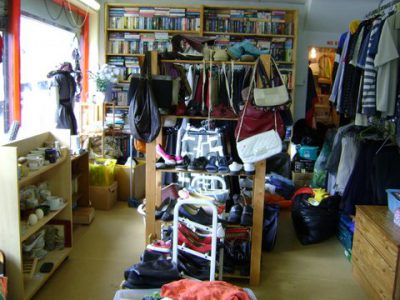 For the last 25 years I have been trawling my way through the discarded clothes and goods you typically find in your local Oxfam, Simon or Cancer Research shop. I’ve also been seeking treasure at sales of work, in skips and the occasional bin. I try and do as much of my present buying as I can in charity shops and flea markets, and I store the finds away from January to December. So you could say it has been a lifelong interest, but obsession would be truer, and there is a touch of ‘shopaholicism’ about it, as the lure of the bargain can take hold. (I remember this happening when a shop in Cork was doing a clearout and let you fill a carrier bag for a pound! I packed six bags with clothes, and while I can only recall one item I can still sense the thrill of dragging those bags home!)
For the last 25 years I have been trawling my way through the discarded clothes and goods you typically find in your local Oxfam, Simon or Cancer Research shop. I’ve also been seeking treasure at sales of work, in skips and the occasional bin. I try and do as much of my present buying as I can in charity shops and flea markets, and I store the finds away from January to December. So you could say it has been a lifelong interest, but obsession would be truer, and there is a touch of ‘shopaholicism’ about it, as the lure of the bargain can take hold. (I remember this happening when a shop in Cork was doing a clearout and let you fill a carrier bag for a pound! I packed six bags with clothes, and while I can only recall one item I can still sense the thrill of dragging those bags home!)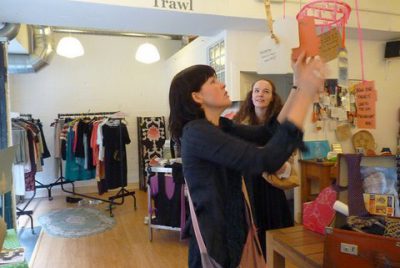 I know some people can’t bear the smells, the clutter, the tatty things and the work involved in searching for something you love in your size, but for me these things are part of the whole. The big draw, which outweighs these and other snags, is the element of surprise. You can’t go with a list to a charity shop, you can’t check the website and calculate it out. You need to rummage and browse, and try and go with the muddled flow.
I know some people can’t bear the smells, the clutter, the tatty things and the work involved in searching for something you love in your size, but for me these things are part of the whole. The big draw, which outweighs these and other snags, is the element of surprise. You can’t go with a list to a charity shop, you can’t check the website and calculate it out. You need to rummage and browse, and try and go with the muddled flow.
There can be a curious kind of community, for a moment or two, when people offer their advice or a find is celebrated. I tried on a red ball dress in the Mater Hospital shop recently and was talked into buying it. I stepped out of the changing room for help with the zip, and a bevy of older women – who know a bargain when they see one – gathered around and sang their praises of the stitching, the swing of the skirt, and the way it fitted me just right.
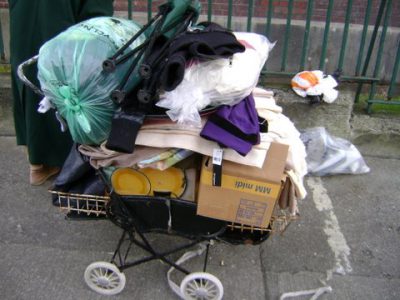 I have great affection for charity shops – for all their faults. Maybe it’s because I first discovered them during a time of great loss in my family; in a strange way I felt like my own brokenness was at home in them. So for me, the main argument for these places relates to hope and patience, and being attentive and maybe even kind to the people around you.
I have great affection for charity shops – for all their faults. Maybe it’s because I first discovered them during a time of great loss in my family; in a strange way I felt like my own brokenness was at home in them. So for me, the main argument for these places relates to hope and patience, and being attentive and maybe even kind to the people around you.I am a writer and performer and charity shops have also been a recurrent theme and inspiration in my work. In my first one woman show, KuddelMuddel – which took place in my flat in Dublin’s city centre – I ended each performance with a mini-auction where I sold off my knick-knacks, many of which I had originally bought in charity shops. I had a string of charity shop jokes in the piece, like the one about a short film I was making, called “Dead People’s Clothes Walking”. I even got to perform KuddelMuddel in a charity shop, as part of the Kilkenny Arts Festival in 2008, when I took over the Oxfam shop for three nights, and the cunning staff attempted to sell off some of my props! We celebrated the community-ness of the place by serving wine and cakes beforehand, and letting people mingle and browse the rails.
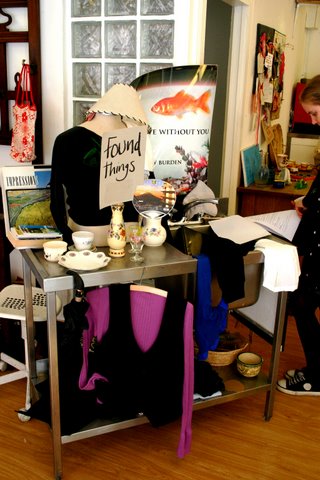 I took my grá* a bit further last September when I opened my own charity shop as part of the ABSOLUT Fringe Festival in Dublin. I called the shop Help Me! Help Me! and I invited people to take my things – gathered from years of charity shop shopping and hoarding – and give me help in exchange. I wanted to see if this would create a temporary community and what it would be like to let strangers help me.
I took my grá* a bit further last September when I opened my own charity shop as part of the ABSOLUT Fringe Festival in Dublin. I called the shop Help Me! Help Me! and I invited people to take my things – gathered from years of charity shop shopping and hoarding – and give me help in exchange. I wanted to see if this would create a temporary community and what it would be like to let strangers help me.I had over 600 things in the shop and about 150 requests for help. The help included advice on various things like: “How can I be less blunt?” (“Before you answer think for two or three seconds – you can change your mind a few times in that time, and be curious about what happens if you don’t say something blunt”), “How can I get on better with my family?” (“Two key words: expectation and boundaries”), “What should I do with my childhood scrapbooks?” (“Keep them – they are not an ever-growing collection and de-cluttering is over rated when it comes to childhood memories”), and “Should I try to cry less or more?” (“You should try to cry more, because there is always a reason to cry and it makes you feel better”).
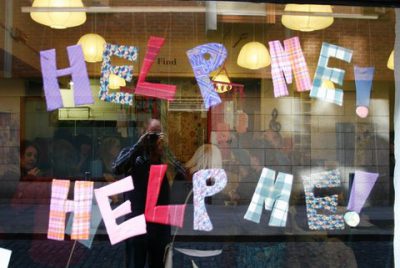 The shop was partly inspired by two phrases from the Bible: “A time to keep and a time to throw away” and “Gather up the fragments that remain, that nothing may be lost”, which both speak to me about loss and trying to make some good out of whatever situation you find yourself in. You can read more about Help Me! Help Me! if you look at www.helpmehelpme.com.
The shop was partly inspired by two phrases from the Bible: “A time to keep and a time to throw away” and “Gather up the fragments that remain, that nothing may be lost”, which both speak to me about loss and trying to make some good out of whatever situation you find yourself in. You can read more about Help Me! Help Me! if you look at www.helpmehelpme.com.Like I said at the start, it’s good to be open to those around you. Let me illustrate: in Oxfam one day I asked if I could try on a ring that was sitting in the locked cabinet. The woman insisted it was a napkin holder but let me try it on anyhow. I got the thing stuck on my finger and the woman suggested a solution. Other people in the shop gathered around and suggested more remedies. In the end I counted eight.
